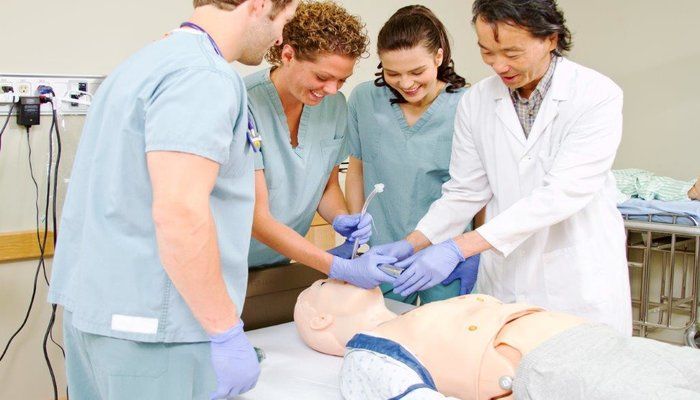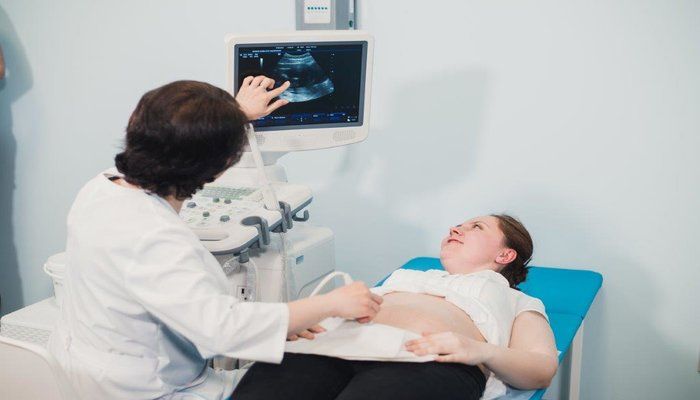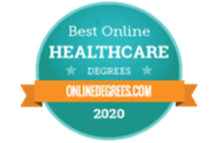
For several years, healthcare occupations have topped every list for most in-demand careers, and this year is no exception. The U.S. Bureau of Labor Statistics (BLS) predicts that the healthcare sector will add 1.9 million new jobs in the decade leading up to 2028. In fact, the BLS expects healthcare occupations to add more new jobs than any other sector.
Although it is possible to enter the healthcare sector in various roles with an associate degree, there is a push for personnel involved in direct care of patients, like nurses for example, to obtain bachelor’s degrees as more hospitals try to achieve the coveted ‘Magnet Status’ for providing excellent healthcare. Additionally, the BLS reports that individuals with bachelor’s degree earn an average of $306 (or 25 percent) more per week than those with associate degrees.
But for many students, attending college courses on campus presents challenges, including fitting class times into a work schedule, addressing child care or simply being too far away from the program. Online healthcare degree programs can provide quality education to get you into these fast-growing careers more quickly, while providing the flexibility you need for your life — whether you’re a recent high school grad, a career changer or an older student returning to school.
Using data from the BLS, National Center for Education Statistics (NCES) and Integrated Postsecondary Education Data System (IPEDs) we examined online healthcare degree programs to find out which majors brought the greatest return on investment — in money, time and growth in the future. Read more about our methodology at the bottom of the page.
The following online healthcare degree programs were our winners. As you can see, each one differs in content and requirements, and some degree programs may not be offered 100 percent online (because they require on-campus clinical components, for example).

The first major on our list has the distinction of being offered as a bachelor’s degree program in the largest number of online colleges — by a huge margin. This is likely due to the fact that it also has the largest number of projected job openings, a demand that must be filled due to the critical role nurses play in the healthcare field. In fact it’s hard to imagine how the healthcare industry would function without registered nurses (RNs) providing nurturing care for the sick, promoting health and wellness through patient education and listening carefully to the needs and concerns of patients in order to provide the best possible medical care.
Online nursing degrees can help you gain the practical and theoretical skills to enter one of the most trusted professions in our country. Coursework usually includes such subjects as anatomy and physiology, chemistry, nutrition, pharmacology, psychology, health assessment, adult nursing, maternity nursing or mental-health nursing. Graduates must then pass the National Council Licensure Exam for Registered Nurses (NCLEX-RN) to earn the RN credential.
Featured data points:
- Annual median wage of each occupation matched to the major, 2018: $72,610
- Annual 75th percentile wage of each occupation matched to the major, 2018: $92,870
- No. of schools offering this degree online at the bachelor’s level: 466
- Average projected growth rate of all jobs matched to each major, 2018-28: 19.4%
- Total number of jobs projected in 10 years of all occupations matched to the major, 2018-28: 3,476,400
- Percentage of industries employing the occupations matched to the major, 2018-28: 22.31%

Despite the small number of online degree programs (which have increased since last year), the second degree on our list commands the highest salary in our ranking and the largest number of industries hiring people with this training for the third year in a row.
Medical informatics is where applied information technology (IT) meets healthcare. Students can learn the skills they need to design software specifically for the healthcare industry so that patient data can be organized, retrieved easily and stored securely. Apart from IT subjects like application programming, students in an online medical informatics course can expect to study healthcare subjects like healthcare coding and classification and medical terminology that will help them design healthcare information systems effectively. Business and management subjects included in the course can also help students develop the leadership skills needed for managerial roles in the field of healthcare information.
Featured data points:
- Annual median wage of each occupation matched to the major, 2018: $104,087
- Annual 75th percentile wage of each occupation matched to the major, 2018: $132,333
- No. of schools offering this degree online at the bachelor’s level: 9
- Average projected growth rate of all jobs matched to each major, 2018-28: 19.57%
- Total number of jobs projected in 10 years of all occupations matched to the major, 2018-28: 1,430,900
- Percentage of industries employing the occupations matched to the major, 2018-28: 44.94%

With the second-highest number of schools offering this bachelor’s degree via distance education, healthcare administration is a major that could prepare you for work running, or helping to run, a healthcare service facility. As our nation continues to evaluate how best to deliver and pay for effective healthcare, well-trained administrators will be needed to lead this change and oversee how facilities operate. You’ll notice that healthcare administration/management actually occupies three spots on our list, though the degree emphases may differ; for example, some programs focus on health services organizations or hospital settings, whereas other programs have a more broad healthcare focus. Healthcare administrators and managers typically oversee healthcare facilities, from individual practices to hospitals or departments.
A healthcare administration/management degree program usually covers broad healthcare topics such as epidemiology or anatomy and physiology and also provides skills in legal and business issues, with courses such as accounting, healthcare law and policy, ethics and finance.
Featured data points:
- Annual median wage of each occupation matched to the major, 2018: $99,730
- Annual 75th percentile wage of each occupation matched to the major, 2018: $130,820
- No. of schools offering this degree online at the bachelor’s level: 206
- Average projected growth rate of all jobs matched to each major, 2018-28: 19.8%
- Total number of jobs projected in 10 years of all occupations matched to the major, 2018-28: 422,000
- Percentage of industries employing the occupations matched to the major, 2018-28: 27.8%

Though a student can earn an RN credential without a bachelor’s degree, a nursing practice degree is a Bachelor of Science in nursing (BSN), which can provide a higher level of skills to help gain a competitive edge in the job market; the BLS says that those with a BSN will have better job prospects. On our list, nursing practice degree holders enjoy higher salaries, on average, than RNs, and a higher number of industries where they may be employed.
This program includes coursework similar to that of RNs, including anatomy and physiology, microbiology and pharmacology, but expands on that with skills in communications/writing, behavioral health, and public health or health specialties like pediatrics.
Featured data points:
- Annual median wage of each occupation matched to the major, 2018: $92,830
- Annual 75th percentile wage of each occupation matched to the major, 2018: $114,870
- No. of schools offering this degree online at the bachelor’s level: 7
- Average projected growth rate of all jobs matched to each major, 2018-28: 4,025,700
- Total number of jobs projected in 10 years of all occupations matched to the major, 2018-28: 23.53%
- Percentage of industries employing the occupations matched to the major, 2018-28: 28.19%

For students who want to lead nursing staffs, a nursing administration degree may be for you. While this is typically a graduate degree program, you may find some online nursing degrees offering this specialization at the undergraduate level too. Nurse administrators handle managerial duties such as scheduling and training nurses, giving performance reviews, managing departmental budgets and serving as liaisons between nurses and other medical staff. Nurses, who are interested in this aspect of the job, typically need a few years of experience under their belts to qualify.
This degree program includes coursework in advanced nursing practices as well as ethics and policy, organizational management, leadership, human resources management and finance. As with many healthcare degrees, you may require a practicum in which you can be asked to apply your hands-on skills in certain real-life administrative situations.
Featured data points:
- Annual median wage of each occupation matched to the major, 2018: $85,730
- Annual 75th percentile wage of each occupation matched to the major, 2018: $109,585
- No. of schools offering this degree online at the bachelor’s level: 13
- Average projected growth rate of all jobs matched to each major, 2018-28: 17.3%
- Total number of jobs projected in 10 years of all occupations matched to the major, 2018-28: 3,814,200
- Percentage of industries employing the occupations matched to the major, 2018-28: 33.18%

This degree has the largest projected job growth and employment numbers on our list. It’s designed to provide currently licensed RNs with a bachelor’s degree, typically called an RN-to-BSN program. Such programs enable nurses to specialize in areas that include nursing administration, nursing research and clinical nursing. Clinical experience is often a requirement of this degree program, and students are prepared upon graduation to enter graduate school if they wish to earn advanced nursing training.
Coursework may include healthcare informatics and public health, as well as special population nursing such as pediatric and parent-child nursing, medical surgical nursing or nursing care of people with chronic illnesses.
Featured data points:
- Annual median wage of each occupation matched to the major, 2018: $84,083
- Annual 75th percentile wage of each occupation matched to the major, 2018: $103,727
- No. of schools offering this degree online at the bachelor’s level: 18
- Average projected growth rate of all jobs matched to each major, 2018-28: 24.93%
- Total number of jobs projected in 10 years of all occupations matched to the major, 2018-28: 3,687,900
- Percentage of industries employing the occupations matched to the major, 2018-28: 20.95%

This degree is the practical application of medical informatics. As healthcare laws for hospitals, physicians and insurers continue to change and electronic medical records evolve to become more comprehensive and efficient, the role of health information managers and administrators should grow in importance. Online health information management programs train students to become professionals who help to guide hospitals and healthcare practices by collecting and analyzing patient data and ensuring compliance with various healthcare laws.
Online health information degree programs usually include coursework in medical terminology, computer technology, coding and billing, as well as such topics as human resources management, health law, pharmacology, and quality improvement.
Featured data points:
- Annual median wage of each occupation matched to the major, 2018: $99,730
- Annual 75th percentile wage of each occupation matched to the major, 2018: $130,820
- No. of schools offering this degree online at the bachelor’s level: 75
- Average projected growth rate of all jobs matched to each major, 2018-28: 19.8%
- Total number of jobs projected in 10 years of all occupations matched to the major, 2018-28: 422,000
- Percentage of industries employing the occupations matched to the major, 2018-28: 27.8%

This is another nursing degree that is more commonly found at a graduate level. However, there are online bachelor degree programs in nursing science available for those individuals who want to focus their future careers on conducting research in the field of nursing. Graduates of nursing science degrees can work as RNs (after passing the required licensure examinations, of course) and therefore have the same plentiful job opportunities as those with regular BSN degrees.
Apart from coursework that is included in regular BSN programs, nursing science degree programs also include topics in theory and research-based clinical practice. Graduates of these programs can take the NCLEX-RN exam and go on to work as RNs in various healthcare settings. The demand for nurses in varying capacities has meant that this degree has moved up a rank on our list from last year.
Featured data points:
- Annual median wage of each occupation matched to the major, 2018: $72,610
- Annual 75th percentile wage of each occupation matched to the major, 2018: $92,870
- No. of schools offering this degree online at the bachelor’s level: 8
- Average projected growth rate of all jobs matched to each major, 2018-28: 19.4%
- Total number of jobs projected in 10 years of all occupations matched to the major, 2018-28: 3,476,400
- Percentage of industries employing the occupations matched to the major, 2018-28: 22.31%

In order for doctors to properly diagnose and treat patients, medical tests must provide them with crucial information. With one of the highest salaries on our list, this degree program can equip students who with laboratory and technical skills. An online medical laboratory technology (sometimes called clinical laboratory technology) program can help students gain the science, math, computer and equipment knowledge and critical thinking skills necessary for the job.
Coursework emphasizes the science of medicine, with subjects such as hematology, immunology, microbiology, forensic science, and biotechnology. Students may also study laboratory management techniques along with laboratory math and the use of medical computer software.
Featured data points:
- Annual median wage of each occupation matched to the major, 2018: $97,370
- Annual 75th percentile wage of each occupation matched to the major, 2018: $160,580
- No. of schools offering this degree online at the bachelor’s level: 21
- Average projected growth rate of all jobs matched to each major, 2018-28: 18.7%
- Total number of jobs projected in 10 years of all occupations matched to the major, 2018-28: 485,200
- Percentage of industries employing the occupations matched to the major, 2018-28: 7.01%

This program has maintained its rank at number 10 for the second year in a row. Though its name is less common than the healthcare administration/management degree (No. 3 on our list) and is found in fewer schools, a health services administration degree closely mirrors that one in content and correlates to the same salary and job growth figures. This degree can lead to a career as a health information manager, a health insurance specialist, a health services administrator, a human resources administrator, or a manager for a healthcare-related service organization.
This degree program is a crossover between business and healthcare and coursework typically includes topics in both fields. Students of online health services administration degree programs can expect to takes classes in anatomy and physiology, human resources management, finance, ethics and more.
Featured data points:
- Annual median wage of each occupation matched to the major, 2018: $99,730
- Annual 75th percentile wage of each occupation matched to the major, 2018: $130,820
- No. of schools offering this degree online at the bachelor’s level: 12
- Average projected growth rate of all jobs matched to each major, 2018-28: 19.8%
- Total number of jobs projected in 10 years of all occupations matched to the major, 2018-28: 422,000
- Percentage of industries employing the occupations matched to the major, 2018-28: 27.8%

While this degree program may sound similar to the healthcare administration and health service administration degree programs, it has a special focus on the actual physical environment of healthcare facilities. In the lesser-known hospital and healthcare facilities administration/management degree (offered at only six schools on our list), the opportunities are no less plentiful than they are for similar degrees described earlier on our list.
Students may study specific facilities- related topics like facilities planning, building and operations management, and insurance, among others.
Featured data points:
- Annual median wage of each occupation matched to the major, 2018: $99,730
- Annual 75th percentile wage of each occupation matched to the major, 2018: $130,820
- No. of schools offering this degree online at the bachelor’s level: 6
- Average projected growth rate of all jobs matched to each major, 2018-28: 19.8%
- Total number of jobs projected in 10 years of all occupations matched to the major, 2018-28: 422,000
- Percentage of industries employing the occupations matched to the major, 2018-28: 27.8%

With one of highest job growth rates on our list, many students who choose this major do so to become dental hygienists or use it as a stepping stone to dental school. While individuals can enter this profession with an associate degree, a bachelor’s degree in dental hygiene can give them a competitive edge and also enter the fields of research, teaching, or clinical practice in public or school health programs.
Students majoring in dental hygiene learn how to help people care properly for their mouths and teeth. This means that courses usually include such subjects as nutrition, physiology, dental anatomy, dental hygiene techniques, dental materials, radiography (for use in taking and reading X-rays) and preventive dentistry. You likely will also hone your attention to details and people skills and learn to become comfortable working in people’s mouths.
Featured data points:
- Annual median wage of each occupation matched to the major, 2018: $86,095
- Annual 75th percentile wage of each occupation matched to the major, 2018: $125,095
- No. of schools offering this degree online at the bachelor’s level: 28
- Average projected growth rate of all jobs matched to each major, 2018-28: 22.75
- Total number of jobs projected in 10 years of all occupations matched to the major, 2018-28: 542,800
- Percentage of industries employing the occupations matched to the major, 2018-28: 7.94%

If you’re interested in making a larger-scale impact on the healthcare industry, healthcare policy or the health of communities, this major could be a great choice. It might lead to graduate school or to work as a public health educator, a healthcare manager or administrator, a community health worker or even a school health teacher. A public health degree program can provide you with insights into how government actions, lack of access to healthcare, health education and funding all affect the spread, treatment and prevention of diseases.
Courses may cover such varying topics as infectious diseases, nutrition, biostatistics, ecology, environmental health, human physiology and management of health service organizations.
Featured data points:
- Annual median wage of each occupation matched to the major, 2018: $72,715
- Annual 75th percentile wage of each occupation matched to the major, 2018: $104,428
- No. of schools offering this degree online at the bachelor’s level: 26
- Average projected growth rate of all jobs matched to each major, 2018-28: 19.58%
- Total number of jobs projected in 10 years of all occupations matched to the major, 2018-28: 853,700
- Percentage of industries employing the occupations matched to the major, 2018-28: 18.98%

A medical radiologic technology degree program that equips students to work as radiologic technologists, or the more commonly known x-ray tech, or to be radiation therapists as part of an oncology team, helping to treat cancers. While individuals can enter the field with an associate degree, a bachelor’s degree can lead to further career advancement, such as specializing in a particular area of radiology or leading a radiology team or facility.
Expect coursework in areas such as anatomy and physiology, radiobiology and protection, radiographic exposure, radiographic positioning and radiologic physics. Plus, you’ll develop your attention to detail, spatial awareness and even listening and communication skills, to help you learn to work effectively with patients.
Featured data points:
- Annual median wage of each occupation matched to the major, 2018: $79,740
- Annual 75th percentile wage of each occupation matched to the major, 2018: $112,053
- No. of schools offering this degree online at the bachelor’s level: 13
- Average projected growth rate of all jobs matched to each major, 2018-28: 16.7%
- Total number of jobs projected in 10 years of all occupations matched to the major, 2018-28: 545,700
- Percentage of industries employing the occupations matched to the major, 2018-28: 8.33%

Rounding out our top 15 degrees is diagnostic medical sonography, an industry with the second highest job growth rates on our list. The diagnostic medical sonographer uses ultrasound (high-frequency sound waves that produces images of an individual’s internal organs and structures) to gather data that helps physicians diagnose and treat patients. This program usually leads to an associate degree, but a bachelor’s degree program can allow registered sonographers to advance their careers or specialize in particular areas.
People in this healthcare specialty are crucial in assisting physicians and therapists by providing high-quality images of tissues, organs and, of course, unborn babies still in utero, so proper training in this field is vital. While coursework in human anatomy, medical terminology, microbiology, physiology and pathophysiology, professional ethics, ultrasound physics (including wave theory), vascular technology is a major part of this program it is also grounded in working with patients, developing communication skills and empathy.
Featured data points:
- Annual median wage of each occupation matched to the major, 2018: $84,940
- Annual 75th percentile wage of each occupation matched to the major, 2018: $123,385
- No. of schools offering this degree online at the bachelor’s level: 8
- Average projected growth rate of all jobs matched to each major, 2018-28: 24.55%
- Total number of jobs projected in 10 years of all occupations matched to the major, 2018-28: 376,900
- Percentage of industries employing the occupations matched to the major, 2018-28: 7.24%
METHODOLOGY
For this analysis, we ranked 26 online bachelor’s degrees in healthcare. To be included in the ranking, each major had to:
- Match to a corresponding code in the Classification of Instructional Programs
- Be offered online at the bachelor’s level at five or more institutions
We scored each major on the following data points, using a 10-point scale and the weights specified:
- Annual median wage of each occupation matched to the major, Bureau of Labor Statistics, 2018
- Annual 75th percentile wage of each occupation matched to the major, Bureau of Labor Statistics, 2018
- of schools offering this degree online at the bachelor’s level, National Center for Education Statistics, 2017-18
- Average projected growth rate of all jobs matched to each major, Bureau of Labor Statistics, 2018-28
- Total number of jobs projected in 10 years of all occupations matched to the major, Bureau of Labor Statistics, 2018-28
- Percentage of industries employing the occupations matched to the major, Bureau of Labor Statistics, 2018-28
Please note that while some of the degrees may sound similar, this is the data self-reported by higher education institutes under the Classification of Instructional Programs (CIP) Codes created by the National Center of Education Statistics (NCES) and collected in the Integrated Postsecondary Education Data System (IPEDS).
Methodology Sources
2018 Occupational Employment Statistics and 2018-28 Employment Projections, Bureau of Labor Statistics, BLS.gov; 2018-28 State Occupational Projections, Projections Central, projectionscentral.com
Integrated Postsecondary Education Data System (IPEDS) 2017-18, National Center for Education Statistics, http://nces.ed.gov/ipeds/
Sources:
- Bachelor of Science in Diagnostic Medical Sonography, Advent Health University, https://online.ahu.edu/programs/bachelor-programs/bachelor-of-science-in-diagnostic-medical-sonography/, accessed December 2020
- Bachelor of Science: Nursing, Western Governors University, https://www.wgu.edu/online-nursing-health-degrees/rn-to-bsn-nursing-bachelors-program/, accessed February 2020
- BS in Informatics – Healthcare Informatics, Liberty University, https://www.liberty.edu/online/business/bachelors/healthcare-informatics/, accessed February 2020
- BS in Nursing Science, University of California – Irvine, https://nursing.uci.edu/programs/bs/, accessed February 2020
- BS in Public Health, Walden University, https://www.waldenu.edu/online-bachelors-programs/bs-in-public-health, accessed February 2020
- Career: Dental Hygienists, Big Future, The College Board, https://bigfuture.collegeboard.org/careers/health-technology-dental-hygienists, accessed February 2020
- Dental Hygienists, Bureau of Labor Statistics, U.S. Department of Labor, Occupational Outlook Handbook, https://www.bls.gov/ooh/healthcare/dental-hygienists.htm, accessed February 2020
- Diagnostic Medical Sonographers and Cardiovascular Technologists and Technicians, Including Vascular Technologists, Bureau of Labor Statistics, U.S. Department of Labor, Occupational Outlook Handbook, https://www.bls.gov/ooh/healthcare/diagnostic-medical-sonographers.htm, accessed February 2020
- Elka Torpey, Education pays, Career Outlook, U.S. Bureau of Labor Statistics, February 2019, https://www.bls.gov/careeroutlook/2019/data-on-display/education_pays.htm
- Health Informatics Distance Learning Course, University of Alabama at Birmingham, https://www.amia.org/amia10x10/uab-course-description, accessed February 2020
- Hospital and Health Care Facilities Administration/Management, IPEDS, https://nces.ed.gov/ipeds/cipcode/cipdetail.aspx?y=55&cipid=88762, accessed February 2020
- Major: Clinical Laboratory Science, Big Future, The College Board, https://bigfuture.collegeboard.org/majors/health-professions-related-clinical-sciences-clinical-laboratory-science-clinical-laboratory-science, accessed February 2020
- Major: Dental Hygiene, Big Future, The College Board, https://bigfuture.collegeboard.org/majors/health-professions-related-clinical-sciences-dental-hygiene, accessed February 2020
- Major: Diagnostic Medical Sonography, Big Future, The College Board, https://bigfuture.collegeboard.org/majors/health-professions-related-clinical-sciences-allied-health-diagnosis-intervention-treatment-diagnostic-medical-sonography, accessed February 2020
- Major: Health Services Administration, Big Future, The College Board, https://bigfuture.collegeboard.org/majors/health-professions-related-clinical-sciences-health-medical-administrative-services-health-services-administration, accessed February 2020
- Major: Hospital Facilities Administration, Big Future, The College Board, https://bigfuture.collegeboard.org/majors/health-professions-related-clinical-sciences-health-medical-administrative-services-hospital-facilities-administration, accessed February 2020
- Major: Medical Radiologic Technology, Big Future, The College Board, https://bigfuture.collegeboard.org/majors/health-professions-related-clinical-sciences-allied-health-diagnosis-intervention-treatment-medical-radiologic-technology, accessed February 2020
- Major: Medical Records Administration, Big Future, The College Board, https://bigfuture.collegeboard.org/majors/health-professions-related-clinical-sciences-health-medical-administrative-services-medical-records-administration, accessed February 2020
- Major: Nursing Science, Big Future, The College Board, https://bigfuture.collegeboard.org/majors/health-professions-related-clinical-sciences-nursing-nursing-science, accessed February 2020
- Nurse Administrator, Nurse.org, https://nurse.org/resources/nurse-manager/, accessed February 2020
- Nursing Administration, IPEDS, https://nces.ed.gov/ipeds/cipcode/cipdetail.aspx?y=55&cipid=88815, accessed February 2020
- Nursing Practice, IPEDs, https://nces.ed.gov/ipeds/cipcode/cipdetail.aspx?y=55&cip=51.3818, accessed February 2020
- Online Health Services Administration, BS, University of Central Florida Online, https://www.ucf.edu/online/degree/health-services-administration-b-s/, accessed February 2020
- Online Nursing and Healthcare Degrees from Drexel University, Drexel University, https://online.drexel.edu/online-degrees/nursing-degrees/index.aspx, accessed February 2020
- Radiologic and MRI Technologists, Bureau of Labor Statistics, U.S. Department of Labor, Occupational Outlook Handbook, https://www.bls.gov/ooh/healthcare/radiologic-technologists.htm, accessed February 2020
- Registered Nursing, Nursing Administration, Nursing Research and Clinical Nursing, Other, IPEDS, https://nces.ed.gov/ipeds/cipcode/cipdetail.aspx?y=55&cipid=89046, accessed February 2020
- What is a Magnet Hospital? Duquesne University, https://onlinenursing.duq.edu/blog/what-is-a-magnet-hospital/, accessed February 2020
- What is Health Informatics?, Michigan Tech, https://www.mtu.edu/health-informatics/what-is/, accessed February 2020

